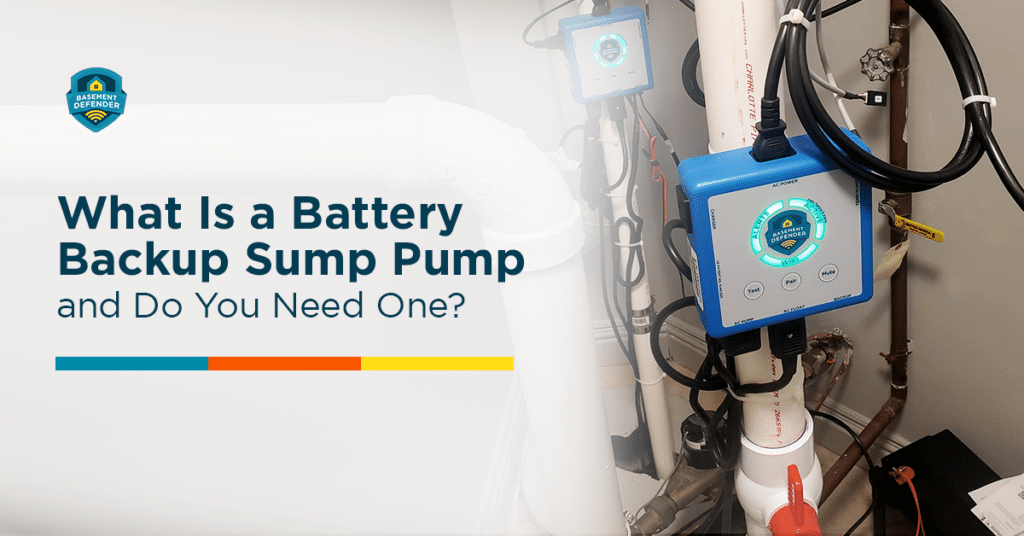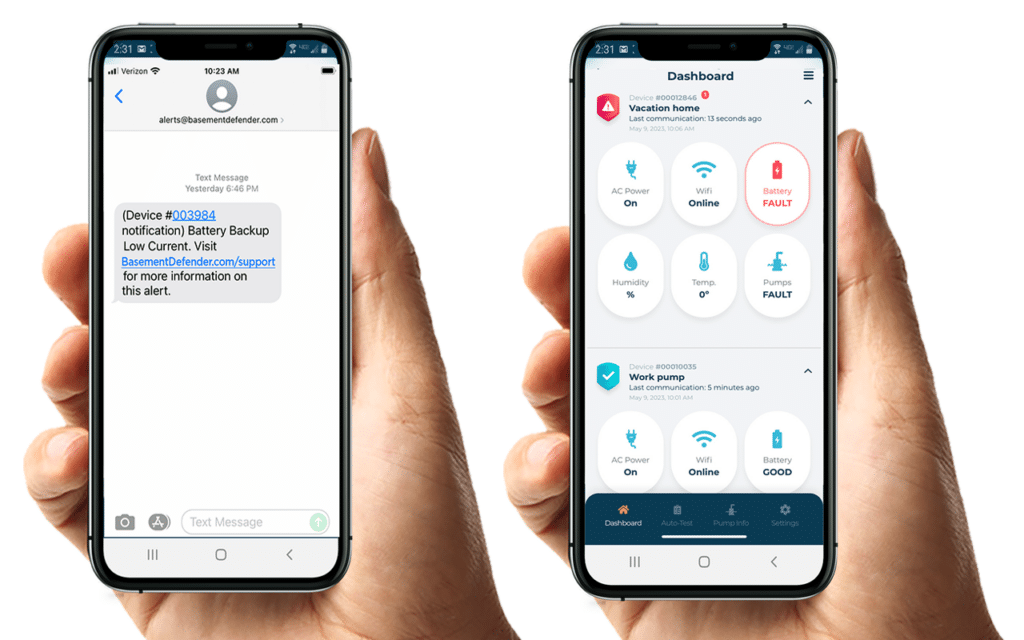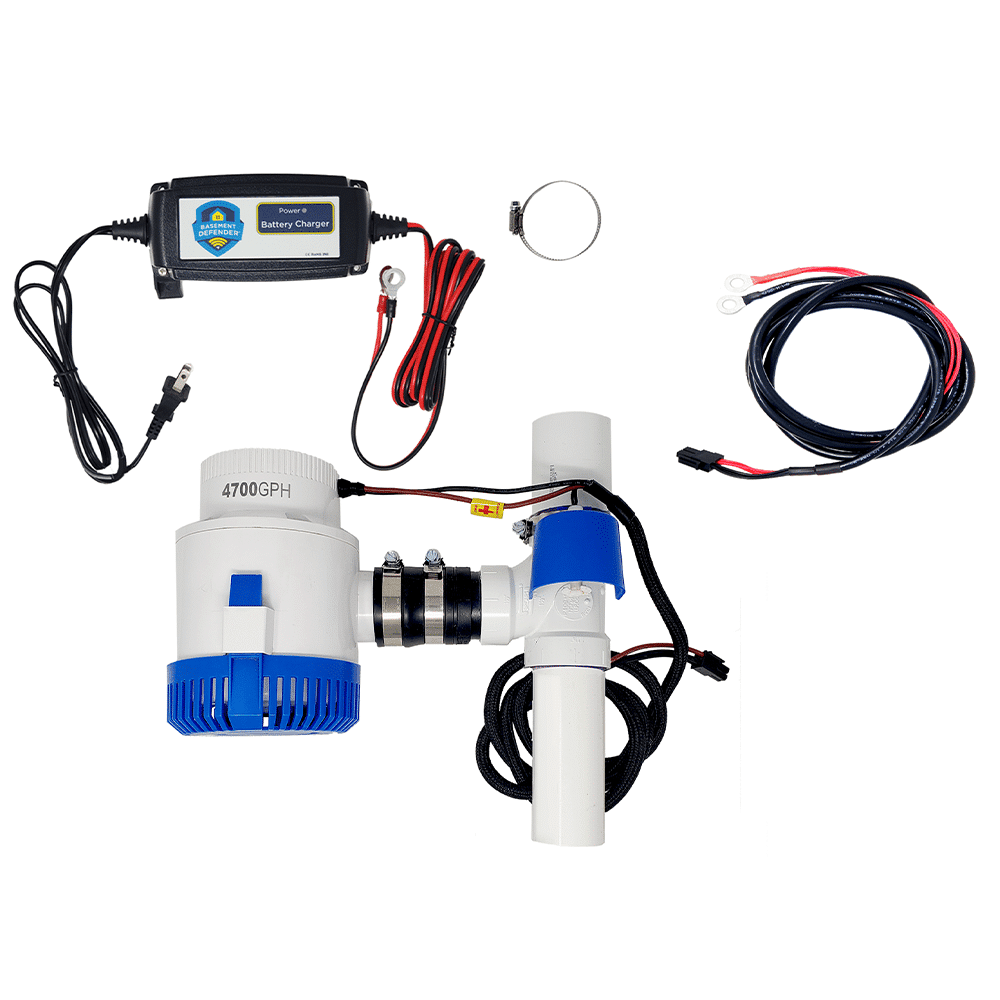
Picture this: you’re putting the finishing touches on your dream basement setup. The pool table sits next to the bar, and your large flat-screen TV hangs on the wall opposite a comfy couch. It starts raining, but you’re not worried because you have a sump pump connected and primed.
However, the power suddenly gets cut, and your system lacks the electricity to protect your precious space.
A reliable sump pump system can be the difference between a flooded basement and the mancave of your dreams. Water damage can cause significant long-term damage to your home and personal belongings in minutes. Thankfully, there’s a solution: a battery backup sump pump.
This guide covers everything you need to know about battery sump pumps and whether they’re a good investment for your home.
A battery backup sump pump is a secondary pump system designed to work with your primary system by automatically triggering past a certain water level. It relies on battery power to pump water out of your basement in case of a power outage or primary sump pump failure.
Imagine a scenario where a storm hits your area, and your basement floods, leaving you unable to return home. In situations like this, relying on a generator to power your primary sump pump system may not be effective if the generator fails or if you can’t access it. However, a battery backup sump pump can protect your home, even in your absence, without requiring manual intervention.
Sump pumps discharge water that accumulates around your home from the water table in the ground.
With a battery backup sump pump, your choice of battery can significantly affect your pump’s performance. You can differentiate a battery by how it handles the electrolyte in the system.
Note that some terms like deep-cycle and maintenance-free don’t indicate the type of battery but simply list features.
This battery is probably the one you’re most familiar with. It relies on an electrolyte fluid that depletes over time, requiring frequent refilling. It has the least durability and requires the most maintenance.
Gel-cell batteries are a slight step up from flooded batteries in terms of lifespan and required maintenance. This battery type uses silica gel as the electrolyte, making spills less likely.
This battery type uses a fiberglass mat to absorb and hold the electrolyte solution, making them spill-proof and maintenance-free. AGM batteries last long on standby and handle cycling exceptionally well. This battery is the gold standard for battery sump pumps.
It’s important to note that 12V batteries have different Ah (Amp hours) ratings, which is how long a battery will last during a power outage. When choosing a battery backup system for your sump pump, consider your specific needs and the potential length of power outages in your area. A larger capacity battery with a higher Ah rating may be necessary for longer outages, while a smaller battery may suffice for shorter outages.
A battery backup sump pump is like insurance for your basement’s primary pump—you hope you never need it, but you’ll be glad if you do. Below are reasons why having one for your home would be advantageous.
A battery backup sump pump automatically works when there’s no power, no backup generator, and your primary pump fails. So long as you charge your battery, your pump is ready to keep your basement water-free.
Basement flooding can cause irreversible damage to your property and belongings in no time. Cleaning and repairing an average-sized basement can cost up to $7,000, not including replacing furniture. A battery backup sump pump reduces this financial vulnerability substantially, often at a fraction of the cost.
If you rely too much on your primary pump system, it may start to wear out quickly. Your backup sump pump assists your primary pump, preventing wear and tear and adding pumping power if your primary pump is overwhelmed.
During a storm, the last thing you want to worry about is the possibility of your basement flooding. A battery backup sump pump ensures your things are protected so you can focus on keeping yourself and your family safe.

If you’re still curious about battery backup sump pumps, here are some quick answers to frequently asked questions.
Every homeowner with a basement should consider a battery backup sump pump, but more so if you reside somewhere that experiences frequent power outages or severe weather conditions. You should also consider a backup if your primary pump is old and potentially unreliable.
When selecting a DC backup pump for a 12V battery, there are a few limitations to consider. The head height (the maximum height that the pump can lift water) and the water capacity (the amount of water the pump can move per minute) are two important factors to keep in mind.
These limitations will vary depending on the specific pump you choose, so it’s important to carefully research and compare different options to find one that meets your needs.
Additionally, it’s important to ensure that the pump is compatible with your 12V battery and has a reliable backup power source in case of a power outage.
The durability of a battery backup sump pump varies depending on factors like its quality, usage frequency, and battery quality. Typically, a backup pump system lasts around 10 years on average. Regarding battery life, a 12V battery can last up to 8 hours with continuous use or several days with intermittent use.
All pump systems, including battery backup sump pumps, require regular maintenance. You should check the battery charge level, test the pump periodically, and replace the battery when necessary.
Some pumps have features that simplify maintenance and operation, like the Basement DefenderTM App.

This app provides text alerts and push notifications for sump pump problems, as well as data on temperature, humidity, battery, power, and WiFi signal. You can also access account information and view multiple Defenders on a single account.
A sump pump battery backup kit can run you anywhere from $200 to $800 without accounting for the cost of a battery. Basement DefenderTM’s Battery Backup Kit costs $245.

This set comes pre-assembled, is easy to install, and is compatible with the Basement DefenderTM Unit. The DC Defender offers a powerful pumping capacity, with 31.31 gallons per minute and 8.15 hours of continuous run time. The kit also includes a 3Amp 12V battery supercharger.
Many of these systems are designed with simplicity in mind and can be installed without professional help. Many backup pump systems come pre-assembled and include easy-to-follow instructions, making the installation a breeze for even the least experienced DIY homeowner.
A battery backup sump pump can be the difference between your dream basement and a pile of water damage repair bills. It’s a valuable investment that can protect your home and wallet under any circumstances.
Basement DefenderTM provides a top-notch sump pump monitoring system, including backup kits and other accessories, that give you peace of mind and save your basement from water damage.
Our product comes with testing and alarm features to detect any issues early and prevent costly damage from flooding caused by sump pump malfunction.

Roy is a respected authority in the waterproofing industry, with over 40 years of experience under his belt. His company, Perma-Seal, has earned a reputation as Chicagoland’s premier waterproofing contractor, thanks to Roy’s unwavering commitment to quality, integrity, and customer satisfaction.
His latest innovation, the Basement Defender, is a testament to his dedication to providing homeowners with the best possible protection against basement flooding, representing a major leap forward in the industry’s efforts to prevent water damage and save homeowners from costly repairs.